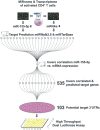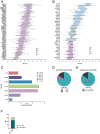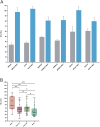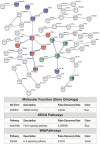Expanding the immune-related targetome of miR-155-5p by integrating time-resolved RNA patterns into miRNA target prediction
- PMID: 39760255
- PMCID: PMC11730359
- DOI: 10.1080/15476286.2025.2449775
Expanding the immune-related targetome of miR-155-5p by integrating time-resolved RNA patterns into miRNA target prediction
Abstract
The lack of a sufficient number of validated miRNA targets severely hampers the understanding of their biological function. Even for the well-studied miR-155-5p, there are only 239 experimentally validated targets out of 42,554 predicted targets. For a more complete assessment of the immune-related miR-155 targetome, we used an inverse correlation of time-resolved mRNA profiles and miR-155-5p expression of early CD4+ T cell activation to predict immune-related target genes. Using a high-throughput miRNA interaction reporter (HiTmIR) assay we examined 90 target genes and confirmed 80 genes as direct targets of miR-155-5p. Our study increases the current number of verified miR-155-5p targets approximately threefold and exemplifies a method for verifying miRNA targetomes as a prerequisite for the analysis of miRNA-regulated cellular networks.
Keywords: CD4+ T cell activation; miR-155-5p; miRnomics; target prediction; time-resolved RNA patterns; transcriptomics.
Conflict of interest statement
No potential conflict of interest was reported by the authors.
Figures




Similar articles
-
Time Series miRNA-mRNA integrated analysis reveals critical miRNAs and targets in macrophage polarization.Sci Rep. 2016 Dec 16;6:37446. doi: 10.1038/srep37446. Sci Rep. 2016. PMID: 27981970 Free PMC article.
-
Integrative analysis of gene and microRNA expression profiles reveals candidate biomarkers and regulatory networks in psoriasis.Medicine (Baltimore). 2024 Jul 19;103(29):e39002. doi: 10.1097/MD.0000000000039002. Medicine (Baltimore). 2024. PMID: 39028999 Free PMC article.
-
Wrinkle in the plan: miR-34a-5p impacts chemokine signaling by modulating CXCL10/CXCL11/CXCR3-axis in CD4+, CD8+ T cells, and M1 macrophages.J Immunother Cancer. 2020 Nov;8(2):e001617. doi: 10.1136/jitc-2020-001617. J Immunother Cancer. 2020. PMID: 33229509 Free PMC article.
-
Experimental capture of miRNA targetomes: disease-specific 3'UTR library-based miRNA targetomics for Parkinson's disease.Exp Mol Med. 2024 Apr;56(4):935-945. doi: 10.1038/s12276-024-01202-5. Epub 2024 Apr 1. Exp Mol Med. 2024. PMID: 38556547 Free PMC article.
-
Inner Mongolian Cashmere Goat Secondary Follicle Development Regulation Research Based on mRNA-miRNA Co-analysis.Sci Rep. 2020 Mar 11;10(1):4519. doi: 10.1038/s41598-020-60351-5. Sci Rep. 2020. PMID: 32161290 Free PMC article.
Cited by
-
A spatio-temporal brain miRNA expression atlas identifies sex-independent age-related microglial driven miR-155-5p increase.bioRxiv [Preprint]. 2025 Mar 16:2025.03.15.643430. doi: 10.1101/2025.03.15.643430. bioRxiv. 2025. Update in: Nat Commun. 2025 May 17;16(1):4588. doi: 10.1038/s41467-025-59860-6. PMID: 40161726 Free PMC article. Updated. Preprint.
-
A spatio-temporal brain miRNA expression atlas identifies sex-independent age-related microglial driven miR-155-5p increase.Nat Commun. 2025 May 17;16(1):4588. doi: 10.1038/s41467-025-59860-6. Nat Commun. 2025. PMID: 40382330 Free PMC article.
References
Publication types
MeSH terms
Substances
LinkOut - more resources
Full Text Sources
Other Literature Sources
Research Materials
